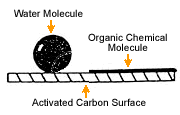Activated Carbon
Activated carbon
Activated carbon (AC) is a natural material derived from bituminous coal, lignite, wood, coconut shell etc., activated by steam and other means, and each one have different adsorption properties (e.g. bituminous carbon for high chlorine reduction capacity). Some manufacturers use various blends of carbon to achieve specific water quality and contaminants reduction (e.g. coconut shell carbon for "sweet taste").
 Activated carbon surface properties are both hydrophobic and oleophilic; that is, they “hate” water but “love” oil. When flow conditions are suitable, dissolved chemicals in water flowing over the carbon surface “stick” to the carbon in a thin film while the water passes on.
Activated carbon surface properties are both hydrophobic and oleophilic; that is, they “hate” water but “love” oil. When flow conditions are suitable, dissolved chemicals in water flowing over the carbon surface “stick” to the carbon in a thin film while the water passes on.
This process is called adsorption. As a result of the adsorption process, activated carbon is an effective method in removing chlorine and it's by-products (TTHM's) and volatile organic compounds (carbon based VOC's). Both, man-made and naturally occurring including among others:
- alachlor
- atrazine
- benzene
- carbofuran
- carbon tetrachloride
- chlorobenzene
- 2,4-D
- dibromochloropropane (DBCP)
- O, P-dechlorobenzines
- forms of dichloroethylens
- 1, 2-dechloropropane
- cis-1,3-dichloropropylene
- toxaphene
- chlordane
- radon
- lindane
- simazine
- PCB's
- toluene
- xylenes etc.,
Most popular forms of activated carbon used in the treatment of POU drinking water filters are granular activated carbon (GAC), extruded solid carbon block (CB) and powdered activated carbon (PAC).
All activated carbon forms including granulated activated carbon (GAC) have a tremendous surface area resulting from its porous structure. GAC filters degree of effectiveness depends on the flow rate of the water and contact time with the water. If flow rate is excessive their efficiency could be as low as 0% and if the flow rate is slow their efficiency can match and or exceed those of different carbon forms.
